#3E-Wellness/Healing Arts
Text
#INDUSTRIES#3E-Religious/Spiritual Organisations#3E-Wellness/Healing Arts#3E-Immigration/Multiculturalism#3E-Indigenous/Tribal Affairs#3E-Politics/Advocacy#3E-Youth-oriented Industries.#VALUES#3E-Respect#3E-Equality#3E-Fairness#3E-Dignity#3E-Empowerment#3E-Intersectional Justice#3E-Non-Discrimination#3E-Inclusivity#3E-Tolerance#3E-Compassion.#TRAITS#3E-Creativity#3E-Open-Mindedness#3E-Curiosity#3E-Compassion#3E-Healing#3E-Acceptance.#TENSIONS#3E-Opposition to witchcraft as a valid spiritual practice#3E-Intolerance of immigrant and indigenous American cultures
0 notes
Text
Azalin Reviews: Darklord Diamabel
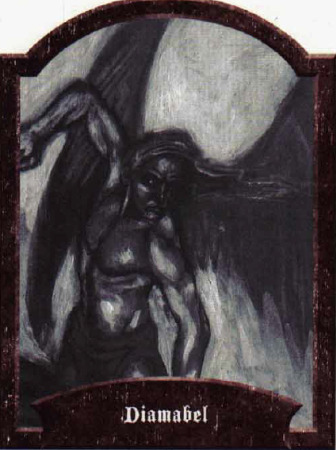
Diamabel the Righteous
Domain:Pharazia
Domain Formation: 590 BC
Power Level: 💀💀💀💀 ⚫
Sources: Domains of Dread (2e), Islands of Terror (2e), Ravenloft Campaign Setting (3e)
(I thought I had scheduled to to post yesterday at 4pm as I normally do for these reviews but somehow had it scheduled to post on the 19th...Not even a Thursday. It has been a long week, my liches.)
Diamabel is the embodiment of all things wrong with religion and one of the many reasons I will never understand its appeal. He rules the domain of Pharazia, a desert as harsh and unyielding as he is.
Diamabel is a typical religious zealot, believing that only his chosen deity and his beliefs are the correct ones and that all others are impure. He grew up on tales of those that lived clean and healthy lives would become beings of pure light. This nonsense was clearly a childhood fancy, but Diamabel, as with most brutes, is not the brightest of individuals (pun intended). Even as a child he saw everything and everyone around him as “unclean”. You know the saying “cleanliness is next to godliness”? Well, Diamabel took that ideal to ridiculous heights.
He started his own doctrine and convinced his people that if they cleansed the land of the impure, they would all become beings of pure light. It’s amazing how quickly people will adhere to a leader spouting absolute rubbish from their lips especially in the name of religious piety. Although, that makes me consider the potential of the Eternal Order if I put a bit more thought and effort into it…Diamabel’s army flew through his desert homeland, slaughtering anyone that did not follow their religion. Eventually, he was slain by a well placed arrow in the stomach as he and his army laid siege on yet another city that did not share his beliefs. When he awoke, the Mists had transported him to his little Island of Terror and granted his wish. Well, as these things go, they granted him all of his desires, but not in the way he envisioned them.
Diamabel awoke as a beautiful being, 7 feet tall with large feathery wings and skin that shimmered under the desert sun, but he was entirely cut off from the deity he swore to uphold. The deity he idolized and blamed his countless murders on and the deity he used to rationalize his hate of everything and everyone that was not like him. If this deity ever existed in the first place, it is unsurprising the being left Diamabel to rot in the mists with the rest of us.At night, he transforms. His angelic appearance gives way to decaying flesh and skeletal wings, a reminder of how far away he is from his deity. He whines about this constantly. You know, some of us are forced to look like decaying skeletons all the time, not just when the sun sets.
Diamabel still obsesses about impurities and his people must abide by his tedious scripture. Those that ignore them met Diamabel’s cruel and unyielding justice. The people of Pharazia, the one city that’s large enough to warrant a name in his impure land, abide by his rule. They are a quiet folk, unwilling or unable to question his law. However, the people that live in the heart of the desert directly oppose him and it is said that their leader, Rashaan, is just as powerful as Diamabel and the only one in Pharazia who can defeat him.
In battle, Diamabel wields the magical, fiery sword Spiritburner. He is a powerful figure, drawing on power from the land around him, though is much like a brute in his tactics. Swinging a sword, fiery or not, is not all that impressive compared to the arcane arts. Mostly his rule consists of posing in front of mirrors during the day and moping at night.
A righteous bastard who never had the favor of any deity, yet continues to enforce his views of purity upon others. Personality aside, Diamabel is, by all accounts, a powerful combatant. With natural healing abilities and the ability to heal himself completely every day, he is not easily taken out directly. Additionally, if one manages to defeat the would-be angel, he turns to ash which in approximately one month collects in the far corner of his Domain and from that ash, he is reborn.
10 notes
·
View notes
Text
Nightmare Beast

Image by Wayne Reynolds, © Wizards of the Coast. Accessed at the Monster Manual II Art Gallery here
[The nightmare beast is one of seven monsters in the Dark Sun Monstrous Compendium that is said to be the most fearsome on Athas barring the Dragon of Tyr. Like, they can’t all be the most fearsome, my dudes. More 90s edginess, I guess. The nightmare beast has been sufficiently popular to turn up in both 3e and 4e, which means there were plenty of versions for me to compare and draw from. The 2e and 4e art both have short, bulldog like jaws, a motif that turns up in a number of Dark Sun creatures. The longer jaws that Reynolds gave it are more distinctive to me (although of course, the 3e version is the first one I saw, so it might just be a nostalgia bias).
The 2e and 4e versions of the nightmare beast are explicitly defilers, the type of magic in Dark Sun that draws the life from other creatures. Defliling is what destroyed most of Athas’ ecosystems, leaving it a dying desert world. It’s a metaphor. So I gave my nightmare beast the ability to deal negative levels, which it had in 2e but lost in all other editions, and gave it the healing thief ability, because it seemed thematically appropriate.]
Nightmare Beast
CR 17 CE Magical Beast
This scaly creature resembles no true animal, but an amalgamation of the worst qualities of many of them. It stands on four legs tipped with saber-like claws, and has a maw of sword-sized teeth. Two curving tusks grow from its lower jaw, and its enormous eyes are red globes.
A nightmare beast is a true terror, a magical mutant that spreads destruction in its wake. All nightmare beasts hate other living things, and they rampage for days on end, destroying buildings, tearing down forests and slaying all in their path. These rampages are interrupted by long sleep, up to a year at a time, but all creatures near a resting nightmare beast dream of its rampages and are worn down psychically. The land around a nightmare beast lair is shattered, scarred, and bereft of most life.
If it sights potential victims a way off, a nightmare beast will often torment them at range with spells or summoned monsters before teleporting into the middle of the group. A nightmare beast prefers to be up close in combat, crushing foes under its feet and goring them with its swiveling tusks. This way it can drain the life from enemies with its teeth and steal their healing spells through magic. Every time it does so, its own spells grow stronger. Nightmare beasts will flee from a fight if they feel threatened, but few creatures are strong enough to concern it.
Nightmare beasts eat what they kill, and have been known to consume pieces of buildings, armor and weapons as well. They do not intentionally collect treasure, but their guts collect small valuables, and those foolish enough to rifle through their droppings may find a few surviving items. The ground tusks and teeth of a nightmare beast are coveted for use as components in making items of the necromancy or evocation schools, but forgeries are much more common than the real deal in markets.
A nightmare beast speaks Abyssal, but rarely has little to say except threats and curses. They can live for centuries.
Nightmare Beast CR 17
XP 102,400
CE Huge magical beast
Init +6; Senses darkvision 60 ft., Perception +23, scent
Aura healing theft (30 ft., Will DC 28), nightmares (1 mile, Will DC 28)
Defense
AC 30, touch 10, flat-footed 28 (-2 size, +2 Dex, +20 natural)
hp 287 (23d10+161)
Fort +20, Ref +15, Will +12; +8 vs. mind-influencing effects
DR 15/magic; Immune ability damage or drain, bleed, curses, divination, energy drain; Resist fire 20; SR 28
Offense
Speed 30 ft.
Melee 2 gores +30 (2d10+9/19-20), bite +30 (2d8+9 plus energy drain), 2 claws +30 (2d6+9)
Space 15 ft.; Reach 10 ft.
Special Attacks defiled casting, energy drain (2 negative levels, Fort DC 28), trample (4d6+13, DC 30)
Spell-like Abilities CL 17th, concentration +24
Constant—mind blank
At will—fireball (DC 20), shout (DC 21), wall of fire
3/day—empowered chain lightning (DC 23), quickened dimension door, disintegrate (DC 23)
1/day—incendiary cloud (DC 25), mass inflict serious wounds (DC 25), summon monster VIII
Statistics
Str 28, Dex 15, Con 25, Int 10, Wis 20, Cha 25
Base Atk +23; CMB +34 (+40 sunder); CMD 46 (48 vs. sunder, 50 vs. trip)
Feats Blind-fight, Critical Focus, Dimensional Agility, Empower SLA (chain lightning), Greater Sunder, Improved Critical (gore), Improved Initiative, Improved Sunder, Power Attack, Quicken SLA (dimension door), Staggering Critical, Stunning Critical
Skills Acrobatics +21, Climb +27, Perception +23
Languages Abyssal
SQ double damage against objects
Ecology
Environment any land or underground
Organization solitary
Treasure incidental
Special Abilities
Aura of Nightmares (Su) All creatures within 1 mile of a nightmare beast must succeed a DC 28 Will save every time they fall asleep or be affected by a nightmare spell. Casting dispel evil on a victim of these nightmares does not stun the nightmare beast, but does automatically dispel the nightmare effect. A nightmare beast’s aura of nightmares does not affect creatures under protection from evil or a similar effect.
Defiled Casting (Su) Any spell-like abilities used by a nightmare beast for 1 round after it deals negative levels with its bite or is healed with its healing theft aura gains a +2 to its save DC.
Double Damage against Objects (Ex) When a nightmare beast makes a full attack against an object or structure, it deals double normal damage.
Healing Theft Aura (Su) Any time a creature casts a spell that heals hit points or channels positive energy to heal within 30 feet of a nightmare beast, it must succeed a DC 28 Will save or half of the healing is redirected to heal the nightmare beast instead of its selected target. The save DC is Charisma based.
136 notes
·
View notes
Text
Wizard Week: Wizards in the Game
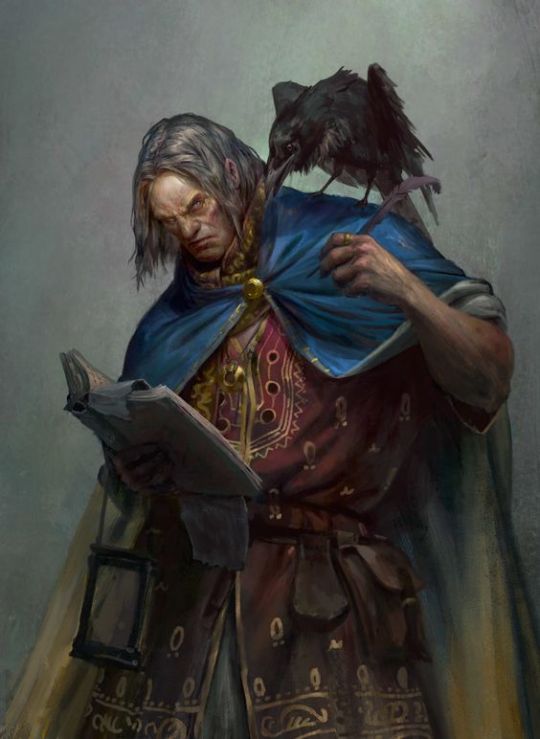
image credit: Tomas Duchek
As a Player
Wizard Strategy: Wizards are some of the most vulnerable characters in the game. They don't have as many innate healing abilities unless you heal from killing creatures as a Necromancer or use the Abjurer's shield feature. Therefore you need to be careful about your positioning in battle. You don't need to worry much against mindless or savage creatures, but intelligent creatures will target the person in the pointy hat with the wand every time. Use your defensive spells to stay out of danger by either teleporting to safety, pushing the enemies away, increasing your AC, or setting up Wall spells.
As a wizard, you have the widest toolkit available and need to choose the right tools for the job. Carefully research dungeons and civilizations you intentionally travel to to get an idea of which spells to prepare. Active volcano? Prepare some fire protection spells. Sunken temple? Prepare water breathing/swimming spells.
The wizard will ultimately fall into either being a utility with a swiss army knife filled with useful spells or else a damage-dealer to wipe out groups of enemies or burst down one creature. Find Familiar is the best spell to have as it essentially gives you advantage on everything you do thanks to the Help action. Once you cast it, you don't really need to prepare it again unless your familiar gets popped.
Preparation: You should ideally have a good mix of all types of spells for all purposes because of how spellcasting works in 5e compared to 3e. Where before you had to prepare a spell at a specific spell slot, now you prepare spells and then cast them spontaneously at whatever spell slot you wish. Because of this, we only need a damaging spell for some spell slots as we can always increase the spell slot if necessary.
At earlier levels, you won't need as many damaging spells. Just keep one powerful area-of-effect spell on hand and fill the rest with utility. A large dungeon is going to need a good toolkit from you. At higher levels, I might suggest every odd-numbered level as this includes the all-important 3rd level Fireball slot but leaves room for other utility spells.
As for the types of spells you want prepared, you need to identify and prepare spells that do what the party lacks. I can't go through every spell but I've provided some of the best examples for each entry.
Crowd/Battlefield Control: A Druid in the party is a master at this, so you can go light on these spells if you have one in the party. Use battlefield control if there is a very powerful enemy to delay or a large number of enemies to divide.
Fog Cloud, Grease, Sleep, Tasha's Hideous Laughter, Thunderwave, Web, Pyrotechnics, Sleet Storm, Fear, Hypnotic Pattern, Banishment, Evard's Black Tentacles, Watery Sphere, Wall of Force, Eyebite, Forcecage, Prismatic Wall
Buffs/Protection: Clerics and Bards are best at this so you don't need as many of these if you have one. Use buffs on your tank when they might get overwhelmed by a swarm of enemies.
Mage Armor/Shield/Mirror Image (for self), Blur, Counterspell, Dispel Magic, Fire Shield, Otiluke's Resilient Sphere, Polymorph, Globe of Invulnerability, Haste
Debuffs: Use debuffs if there are only a few very powerful enemies. Weakening the boss monster is equivalent to buffing the entire party.
Ray of Sickness, Ray of Enfeeblement, Slow, Polymorph
Movement: Maneuvering around the battlefield is essential when you need to turn disadvantage into advantage. Druids can get various movement speeds thanks to Wild Shape, but not usually teleportation.
Expeditious Retreat, Misty Step, Levitate, Fly, Dimension Door, Teleportation Circle, Teleport
Information-Gathering: As a general rule, the Cleric can divine the future (Augury, Commune), but you can see things happening in the present.
Comprehend Languages, Clairvoyance, Detect Magic, Arcane Eye, Scrying, True Seeing
Mental Influence: Bards can use enchantment magic to great effect so you can go light on this stuff if one is in the party. Otherwise, the ability to weasel your way out of encounters or turn enemies into allies is invaluable.
Suggestion, Fear, Hypnotic Pattern, Mass Suggestion, Antipathy/Sympathy
Damage: Warlocks and Sorcerers deal the highest damage as far as magic goes, but you should never not have anything available.
Fire Bolt, Ray of Frost, Magic Missile, Flaming Sphere, Fireball, Melf's Minute Meteors, Sunbeam, Meteor Swarm
Deception: Illusion spells are only limited by the imagination. Bards also excel at illusions.
Minor Illusion, Silent Image, Major Image, Greater Invisibility
Miscellaneous Utility: Mage Hand, Dancing Lights, Message, Alarm, Find Familiar, Leomund's Tiny Hut, Rary's Telepathic Bond, Contingency
Roleplaying the Wizard: Wizards are unique in that they are the only class that learns spells through research. Always be on the prowl for new spells in others' spellbooks and scrolls. Roleplay the actions of copying something to your spellbook. Maybe stop halfway and continue adventuring, claiming that you have hit a snag in trying to decipher a glyph in the source material. Or you could do some experimentation while copying the spell to ensure you are doing it correctly, or search for a special ink that will help make preparing the spell easier in the long run. As a wizard you should always be looking for knowledge with a healthy dose of curiosity for anything unusual.
Magic should be complicated for wizards. Describe the process whenever you cast a spell. Complexity can be faked in a number of ways: unique material components, numerous arcane symbols, complex geometric patterns, intricate gestures, magical devices, etc. Just add some complexity to make it look like magic can't be done by just any country bumpkin.
Seek out other spellcasters and exchange notes to initiate unique roleplaying encounters. How does your wizard view other arcane spellcasters? Warlocks got their magic from a deal with a magical entity, and sorcerers were either born with it or had their souls touched by magic. A wizard, on the other hand, had to work and research for years and spend tons of money learning their craft. Perhaps your wizard is jealous of their expediency, or believes their magic a more crude art with less finesse. On the flip side, they could be intrigued at the unique methods through which they cast spells and seek to learn from them.
Flesh out your character. How does your character dress? How do they speak? How do they carry themselves? Do they have a permanent residence? There are plenty of tropes you can pull from, but try to make your wizard unique. Characters with a high INT score can have many different personalities, quirks, and costumes other than being a know-it-all with a pointed hat in a wizard's tower.
As a DM
Magic is a Science: Wizards are best when learning new spells, since their strength comes from their versatility. Let them do this or else they will simply feel like a weaker version of a sorcerer or warlock. Give them spells and spellbooks to find. Let them invent or find new homebrew spells. Have them take time in a magic laboratory when they level up or describe their process of learning some new spells. Consider allowing wizards to learn spells they witness with an arcana check. (though it will take twice as long and take twice as much gold due to research and experimentation)
Enemies that are wizards will have a spellbook with all the spells they know. Remember to make this available for the PC wizard to find. An NPC wizard away from home will not leave their spellbook far behind, and a wizard in their lair will have their book protected with spells, traps, or have it hidden. Non-wizards can carry spell scrolls which can also be copied by the wizard.
Spell Scroll Table: Here's a link to an easy set of tables for rolling for the contents of random spellbooks and scrolls. It's hard to quickly generate such things on the fly to ensure your wizard PC is getting enough new spells from loot, so having a table like this available is key.
Roleplaying with the Wizard: How do other spellcasters see the wizard? What sorts of magic organizations exist? Magic colleges might focus on specific schools of magic. While the PC wizard can learn spells by simply leveling up, the non-heroic NPC might require years of training to master even a few spells. An institution might not have a wide variety of spells but plenty of research content on one specialty.
Narrate their combat by describing their spells and how they work. Remember that a wizard's magic is very complex so describe it so. Even a Fire Bolt cantrip might burst from a symbol the wizard drew out of reddish energy in midair, or after a specific incantation.
Arcana: Give the wizard arcane puzzles and traps that might not necessarily need an actual spell to solve. A magic lock or trap could probably be foiled with an Arcana check, as could identifying an aura or glyph. The Arcana check is usually only made in reference to actual spells, but a dungeon with plenty of variety should find its use as well.
You should also give them reasons to use their utility spells. Give the players impossible obstacles that could only be overcome with magic. For instance, give them a ridiculously high cliff to climb, or a passage deep under the water, or hide something with invisibility. Sure, the players are an impetuous lot and could probably find a way without magic, but impossible odds will reward the wizard for their preparation, or encourage them to find even more creative uses for the spells they do have prepared.
Challenging the Wizard: Wizards have a hard time dealing with just about anything, including other wizards, without preparation. If you can surprise a wizard, you will be able to best them. They won't have their defensive spells ready, their party won't be buffed, and they may need to waste a slot on an offensive spell instead of a utility spell to quickly dispatch the threat. Wizards don't tire as quickly as warlocks and sorcerers do when it comes to utility, so tiring them out is not usually an option. However, forcing them to choose how they use their spells will present them with unique choices.
Intelligent creatures, once they determine that the character can cast spells, might mercilessly target them. Creatures that know better will know that a fireball is going to hurt them a lot more than a sword from their fighter, and will try to stop that from happening.
Wizards have high mental saving throws, so forcing them to make STR, DEX, and CON saves will usually get their goat. Most spells that deal elemental or poison damage will do the trick for DEX and CON. Grappling, restraining, or otherwise forcing the wizard to lift something will also do them in since it will require STR. Several creatures have innate grappling capabilities that will render the wizard useless if it can land an attack on them.
#Wizard Week#D&D 5e#Dungeons and Dragons#Wizard#Roleplaying#Magic-User#Mage#DnD#DnD 5e#D&D#Noblecrumpet#Dorkvision#Magic#Spells#spellcaster
485 notes
·
View notes
Text
bearded devils (barbazu)
Well I love reading people’s opinions, so I figured I should stop hoarding all these opinions and share some of my own.
It’s time to talk about depictions of my favorite disgusting devils from D&D, the bearded devils / barbazu!
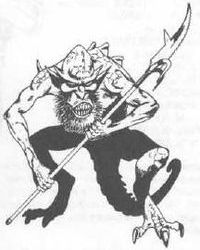
Well, I say they’re my favorite but I’m not really into any of the official art. The one above is from AD&D, aka 2e, and, well, they all go downhill from here.
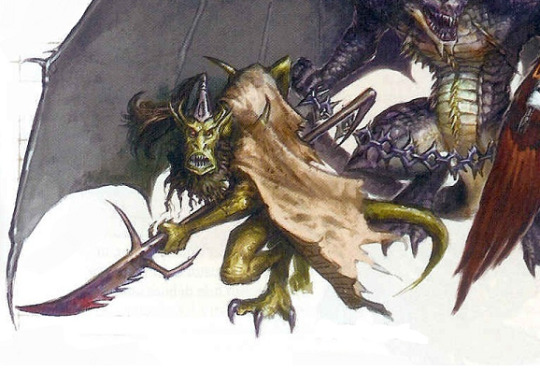
This is the illustration in 3e, and it’s okay I guess, but something about the design just doesn’t jig with me. Maybe it’s the random spikes sticking in all manner of directions, which seems out of place for lawful evil devils, who are all about efficiency. I do like how reptilian it is, cause the contrast of it having a hairy beard makes it all the weirder.
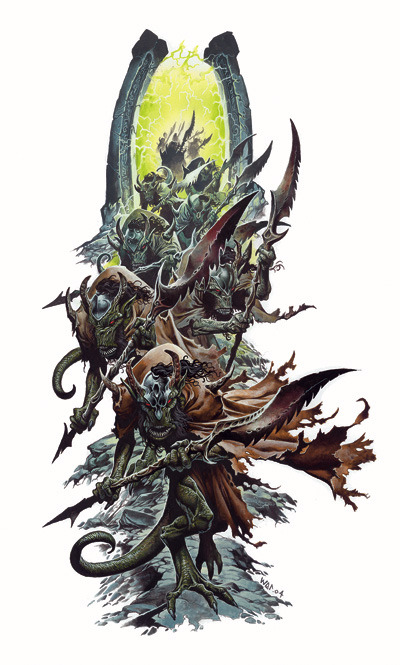
This is also from 3e, a supplement called Heroes of Battle, and well, I love anything by Wayne Reynolds, but I also feel that these ones capture the essence of the bearded devil from the 2e illustration, and adds a ragged cloak that makes them look even filthier! These guys inflict wounds that don’t heal and spread a special disease with their beards, and this illustration is appropriately disgusting. Technically this is the same design as the previous one, but i like their body language a little better in this one.

This is the one from 4e, and, well, I hate it. They really focused on the “devil” aspect more than the filthy, disease-ridden beard, what with the red skin and horns. It’s more or less just a typical “devil” with some snake beard, and while snake beard is a cool idea, the hairy beard is just, well, more beardy.
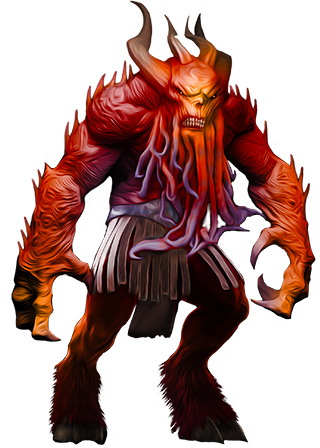
This one’s from Pathfinder, drawn by Rick Hershey. I appreciate how non-human it is, but like the one from 4e, it’s more devil-y than beard-y. The beard’s nice and ragged, but ultimately kinda looks like an afterthought to the design. And this does seem like more of a chaotic demon-y type design than a calculating devil.

This is the 5th edition one, and while I like the overall simplification of the design... that beard looks glued on. It seems they’ve also changed its beard attack from a disease to a poison, so I can’t boohoo about how this one isn’t filthy enough.
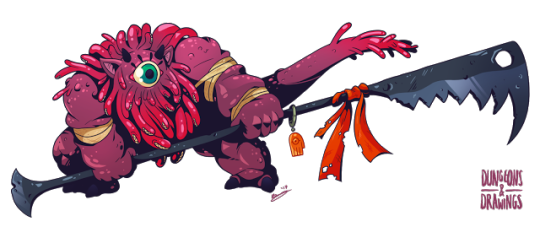
This isn’t an official artwork, it’s by the people at Dungeons and Drawings, but I couldn’t not include it because it’s great. You can tell I’m sore for the hairy beard, but I really like the polyp-y amorphous quality this thing has, which is reasonably disgusting. Plus it’s also pretty cute!
All this griping has made me wanna draw my own version too, so watch out for that.
40 notes
·
View notes
Text
#INDUSTRIES#3E-Spiritual Retreats#3E-Wellness#3E-Healing Arts#3E-Politics#3E-Social Media#3E-Community#3E-Retail#3E-Fashion#3E-Beauty#3E-Diversity and Inclusion.#VALUES#3E-Religious Freedom#3E-Self-Expression#3E-Justice#3E-Healing#3E-Equality#3E-Heritage#3E-Cultural Heritage#3E-Accuracy#3E-Respect#3E-Inclusivity.#TRAITS#3E-Open-mindedness#3E-Authenticity#3E-Inclusivity#3E-Connection#3E-Empowerment#3E-Learning
0 notes
Text
Thri-Kreen

Image by Brian Despain, © Wizards of the Coast. Accessed at the Monster Manual II Art Gallery here
[The thri-kreen was never meant to be a PC race. At least, not originally. They originally appeared in the AD&D Monster Manual II with 6 Hit Dice and a load of special abilities. In Dark Sun, thri-kreen player characters didn’t get all of these abilities all at once, but were partitioned out over the first six levels. The ones with racial HD were called “tohr-kreen”... which then got retconned when 6 HD thri- and tohr-kreen both existed separately later in 2nd edition. The tohr-kreen were forgotten for a long while. 3e made thri-kreen a race with 2 HD and used their level adjustment system. I certainly played a thri-kreen character that abused the heck out of the Multiweapon Fighting chain. 4e toned them down to be a bit more in tune with the player powers of the rest of their Dark Sun races, and 5e went back to the AD&D 1e model, where they are just monsters, not player characters at all.
So I had a lot of history to choose from. I wanted to make them PCs, but that required toning them down significantly from their 3e levels. I created feats that help them get more towards that value, but still not entirely. PFRPG is much stingier with multiple attacks than 3.x was, and a PC race with five attacks from the get-go is right out. A lot of their mechanical flavor has already been swiped by Pathfinder races (the kasatha got the deserts and four arms; the trox got the big bugginess and natural attacks), so I wanted to make sure they were differentiated. I consulted with my friend @bowelfly for what they thought were vital to the feel of a thri-kreen, as they are a connoisseur of bug people.]
Thri-kreen
CR ½ CN Monstrous Humanoid (kreen)
This humanoid mantis is a dusty yellow color. It has four arms, but two seem to be its primary ones. It wears little clothing and carries multiple strange weapons.
The thri-kreen are sometimes called “mantis warriors”, as this describes both their physical appearance and their cultural values. Thri-kreen are nomadic hunters, and combine keen loyalty with a fierce need for competition. Members of a clan would hardly consider betraying one another, but they jockey constantly for position, and fights to the death are not unheard of to obtain a leadership role from a leader considered past their prime. They are skilled and patient hunters, moving frequently to avoid depleting prey items or causing undue ecological stress. Thri-kreen mate for life, and the care of the young is shared between all members of the clan. They grow to adulthood quickly, being mature within 5 years of age, and are considered ancient if they live to the age of 35. Thri-kreen often decorate their chitin exoskeletons with etchings and paints, the latter only for special occasions.
Thri-kreen prefer to attack from ambush, using their ability to change color to hide and their remarkable leaping ability to spring to the attack. The weapons of a thri-kreen are among their only possessions, and are thus well cared for. The primary melee weapon used by thri-kreen is a two-headed, crescent-bladed polearm called a gythka (treat as an orc double axe). As ranged weapons they use oversized shuriken known as chatkcha (treat as a starknife). Unusually, armor is only worn by the boldest and most confident thri-kreen, as it interferes with their camouflage abilities.
Thri-kreen advance by character class. Most of them choose classes with a full base attack bonus, like fighter, ranger or brawler. Their spellcasters are typically psychics, especially with the lore or self-perfection disciplines. Those that cast divine spells are usually druids—they do not trust gods, which they cannot see or taste, as opposed to natural forces which they can.
Thri-kreen as Player Characters
Thri-kreen do not have racial Hit Dice, and advance by character class. A thri-kreen character has the following attributes
+2 Dex, +2 Con, -2 Cha Thri-kreen are nimble and tough, but have alien minds and emotions.
Monstrous Humanoid Thri-kreens are not subject to spells and effects that target humanoids only
Medium Size A thri-kreen gains no benefits or penalties from its size
Low-light vision
+1 natural armor
Normal Speed
Bite A thri-kreen gains a bite attack as a primary natural weapon that deals 1d4 points of damage
Chameleon Skin (Ex) A thri-kreen can change the color of its carapace to match its environment. It gains a +4 racial bonus to Stealth checks if it is wearing no armor and only light clothing. If wearing light armor, or clothing that covers the body, it gains a +2 racial bonus on Stealth checks. If wearing medium or heavy armor, it gains no bonus.
Master Leaper (Ex) A thri-kreen gains a +4 racial bonus on Acrobatics checks made to jump. It takes no penalty to Acrobatics checks made to jump without taking a running start. If it does take a running start, it doubles the distance covered.
Secondary Arms (Ex) The secondary arms of a thri-kreen cannot be used to wield weapons or shields, but can be used to draw or stow small objects as a swift action. They can be used to provide somatic components even if both hands are full.
Weapon Familiarity (Ex) A thri-kreen treats starknives as a simple weapon, and treats orc double axes as a martial weapon.
Languages Thri-kreen start play speaking Kreen. A thri-kreen with an Intelligence bonus may choose from the following languages: Common, Dwarf, Elven, Gnoll, Halfling, Sylvan.
Statistics for a sample thri-kreen character, and feats for thri-kreen characters, under the cut
Thri-kreen ranger 1 CR 1/2
XP 200
CN Medium monstrous humanoid (kreen)
Init +3; Senses low-light vision, Perception +5
Defense
AC 14, touch 13, flat-footed 11 (+3 Dex, +1 natural)
hp 12 (1d10+2)
Fort +4, Ref +5, Will +1
Offense
Speed 30 ft.
Melee double axe +3 (1d8+3/19-20), bite -2 (1d4+1) or double axe +1 (1d8+2/x3), double axe +1 (1d8+1/x3), bite -2 (1d4+1) or bite +3 (1d4+3)
Ranged starknife +4 (1d6+2/x3)
Special Attacks favored enemy (magical beasts +2)
Statistics
Str 15, Dex 16, Con 15, Int 10, Wis 12, Cha 6
Base Atk +1; CMB +3; CMD 16
Feats Two-Weapon Fighting
Skills Acrobatics +4 (+8 when jumping), Climb +6, Heal +5, Knowledge (nature) +4, Perception +5, Stealth +11, Survival +5 (+6 following tracks); Racial Modifiers +4 Acrobatics when jumping, +4 Stealth
Languages Kreen
SQ chameleon skin, mighty leap, track +1, secondary arms, weapon familiarity, wild empathy -1
Ecology
Environment warm deserts and plains
Organization solitary, pair, gang (3-6), patrol (7-12 plus 1 leader of 3rd level) or clan (13-40 plus 50% noncombatants, plus 1-3 leaders of 3rd-7th level)
Treasure NPC gear (double axe, two starknives, other treasure)
Thri-kreen Feats
A thri-kreen’s body and mind can develop in unexpected ways over the course of their lives, enhancing their natural abilities. Thri-kreen may choose from the following feats
Chitinous Claws (Combat Feat)
Your fingers end in sharp claws instead of dull points.
Prerequisites Improved Unarmed Strike, kreen subtype
Benefit: Your unarmed strikes can deal bludgeoning, piercing or slashing damage, as you choose.
Effective Limbs (Combat Feat)
You have trained your secondary limbs until they are as strong as ordinary arms
Prerequisites Str 17+, base attack bonus +6, kreen subtype
Benefit You may use your secondary limbs to wield weapons, hold shields and do anything else a limb can do.
Improved Chameleon Skin
You have great control over your ability to change color
Prerequisites Wis 13+, character level 3rd, kreen subtype
Benefit Your racial bonus to Stealth checks when unarmored increases to +8. When wearing light armor or covering clothing, it decreases to +4.
Improved Venomous Bite (Combat Feat)
You can produce paralytic enzymes at an incredible rate
Prerequisites Con 15+, base attack +9, kreen subtype, Venomous Bite
Benefit You may use the poison from your Venomous Bite feat a number of times per day equal to your level + your Constitution modifier.
Tohr-Kreen Casting
You can tap into the magic of the mantis nobles
Prerequisites Intelligence 13+, character level 5th, kreen subtype
Benefit You gain the following spell-like abilities. 3/day—mage hand; 1/day—blur, invisibility. You use your Hit Dice as your caster level, and your Intelligence modifier for concentration checks.
Venomous Bite (Combat Feat)
You can produce paralytic enzymes in your saliva
Prerequisites Con 13+, base attack +4, kreen subtype
Benefits You may choose to inflict poison on a creature you hit with your bite attack a number of times per day equal to your Constitution modifier
Kreen Poison; bite—injury; save 10 + ½ Hit Dice + Constitution modifier; duration 1/round for 2 rounds; effect 1d4 Dex damage; cure 1 save.
87 notes
·
View notes